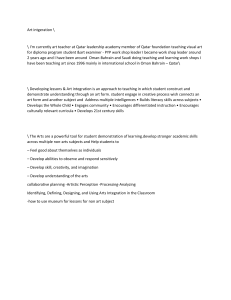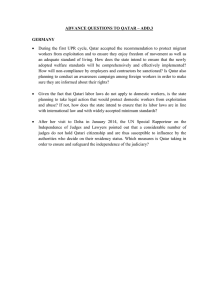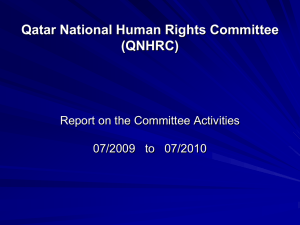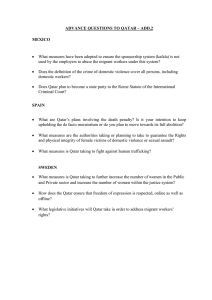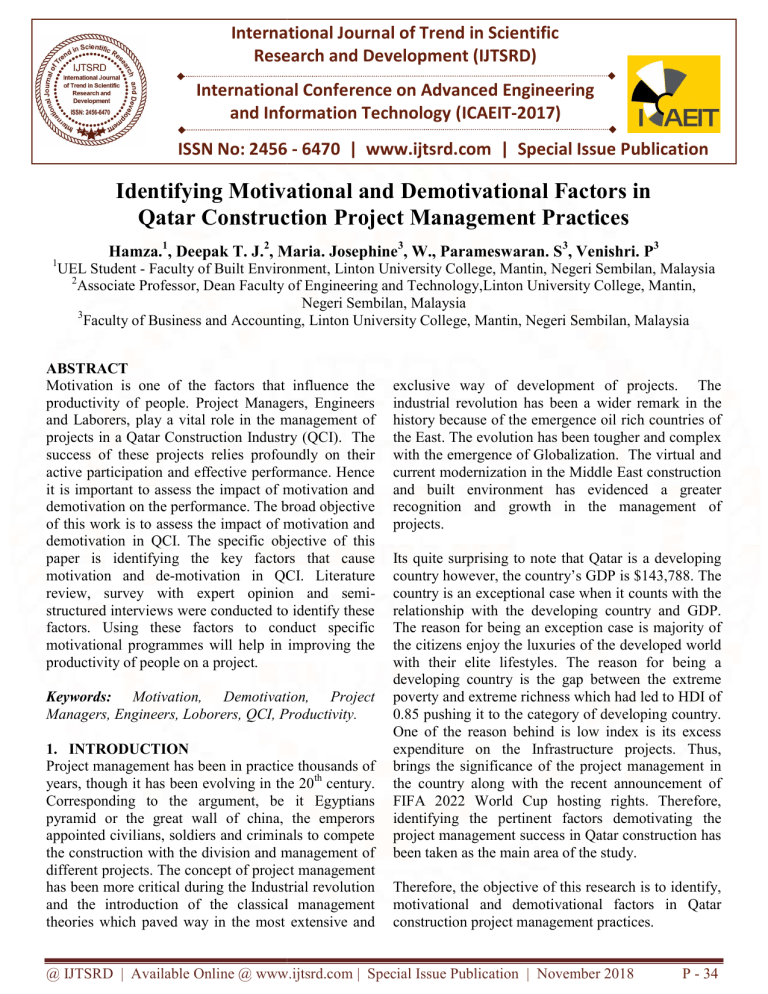
International Journal of Trend in Scientific
Research and Development (IJTSRD)
International Conference on Advanced Engineering
and Information Technology (ICAEIT-2017)
ISSN No: 2456 - 6470 | www.ijtsrd.com | Special Issue Publication
Identifying Motivational and Demotivational Factors in
Qatar Construction Project Management Practices
1
Hamza.1, Deepak T. J.2, Maria. Josephine3, W., Parameswaran. S3, Venishri. P3
UEL Student - Faculty of Built Environment
Environment, Linton University College, Mantin, Negeri Sembilan, Malaysia
2
Associate Professor, Dean Faculty of Engineering and Technology
Technology,Linton
,Linton University College, Mantin,
Negeri Sembilan, Malaysia
3
Faculty of Business and Accounting, Linton University College, Mantin, Negeri Sembilan, Malaysia
ABSTRACT
Motivation is one of the factors that influence the
productivity of people. Project Managers, Engineers
and Laborers, play a vital role in the management of
projects in a Qatar Construction Industry (QCI). The
success of these projects relies profoundly on their
active participation and effective performance. Hence
it is important to assess the impact of motivation and
demotivation
emotivation on the performance. The broad objective
of this work is to assess the impact of motivation and
demotivation in QCI. The specific objective of this
paper is identifying the key factors that cause
motivation and de-motivation
motivation in QCI. Literature
review,
eview, survey with expert opinion and semi
semistructured interviews were conducted to identify these
factors. Using these factors to conduct specific
motivational programmes will help in improving the
productivity of people on a project.
Keywords: Motivation, Demotivation, Project
Managers, Engineers, Loborers, QCI, Productivity.
1. INTRODUCTION
Project management has been in practice thousands of
years, though it has been evolving in the 20th century.
Corresponding to the argument, be it Egyptians
pyramid or the great wall of china, the emperors
appointed civilians, soldiers and criminals to compete
the construction with the division and management of
different projects. The concept of projec
project management
has been more critical during the Industrial revolution
and the introduction of the classical management
theories which paved way in the most extensive and
exclusive way of development of projects. The
industrial revolution has been a wider remark in the
history because of the emergence oil rich countries of
the East. The evolution has been tougher and complex
with the emergence of Globalization. The virtual and
current modernization in the Middle East construction
and built environmentt has evidenced a greater
recognition and growth in the management of
projects.
Its quite surprising to note that Qatar is a developing
country however, the country’s GDP is $143,788. The
country is an exceptional case when it counts with the
relationship with the developing country and GDP.
The reason for being an exception case is majority of
the citizens enjoy the luxuries of the developed world
with their elite lifestyles. The reason for being a
developing country is the gap between the extreme
poverty and extreme richness which had led to HDI of
0.85 pushing it to the category of developing country.
One of the reason behind is low index is its excess
expenditure on the Infrastructure projects. Thus,
brings the significance of the project management in
the country along with the recent announcement of
FIFA 2022 World Cup hosting rights. Therefore,
identifying the pertinent factors demotivating the
project management success in Qatar construction has
been taken as the main area of the study.
Therefore, the
he objective of this research is to identify,
motivational and demotivational factors in Qatar
construction project management practices.
@ IJTSRD | Available Online @ www.ijtsrd.com | Special Issue Publication | November 2018
P - 34
International Journal of Trend in Scientific Research and Development (IJTSRD) | ISSN: 2456-647
1.1. Global Context
According to a recent survey construction projects are
accepted as a prominent factor in many industrialized
countries which contributes to the economy of the
country (Proverbs & Olomolaiye, 1999). 10% of
national income in most of the developing countries
has been a contributed by construction industry
(Navon, 2005). Therefore, the contribution of
construction industry has been more significant in the
developing countries compared to the developed
countries. Thus, bringing the significance of project
management in construction industries in the
developing countries.
1.2. Project vs Project Management
According to Stanley E. Portny (2013), Projects have
been around for ages. For example, the ark built by
Noah, Mona Lisa painted by the famous Leonardo Da
Vinci, the Decline and Fall of the Roman Empire
written by Edward Gibbon, the polio vaccine
developed by Jonas Salk — all projects. These were
all huge projects and very successful ones. Laurie S.
Keller & Mike Field (1998) definition of Project is
that it is methodized task headed for a predefined
target which depends upon resources and effort, a
unique and risky venture containing a schedule and
budget.
Joan Knudson & Ira Bitz (1991) stated that a project
is a properly methodized product which advances
stage by stage having a beginning, end and a
deliverable like a ladder where every step is crucial.
PMI’s edition of PMBOK (2000) defines Project as a
temporary group activity designed to produce a
unique product, service or result. It has a definite
beginning and end in time, and therefore specified
scope and resources. The project is unique which
means that it is not a routine operation, but a specific
set of operations designed to accomplish a singular
goal. Therefore, project teams are made up of staffs
who are not even working all together – sometimes
from different organizations and across multiple
geographies.
Stanley E. Portny (2013) further states that a project is
a brief task implemented to create a unique service,
product, or result. The following three components
are part of every project:
Schedule: timetable with dates stating the project
beginning and end
Required Resources: the crucial elements such as
number of staff, investment and other resources
Specific Scope: Desired result or product
Larry (2002) describes project as short lives since
it has a beginning and an end.
Five Main Characteristics of a Project
A Defined Beginning, End, Schedule, and
Approach
All resources are specifically allocated to the work
Results have specified goals such as (cost, time,
performance/quality)
A planned and organized approach is taken
A group of people are involved
There is always a distinction between project and
project management. A project is a series of activities
established to achieve the specific objectives and
consumes resources over a period of time. A project
should be completed within a specified time and it has
a definite start and end period whereas, project
management is a concept where in a set of rules and
regulations has been applied to control the routine
operation of the company (Munns & Bjeirmi, 1996).
Jack J. Phillips, Wayne Brantley, and Patricia Pulliam
Phillips (2012) definition of Project management is
that it is not a new idea or concept. Project
Management is as ancient as the Egyptian pyramids.
The magnificent pyramids built by the Pharaohs in
ancient Egypt used procedures that remain in mystery
today.
John J. McKeon (2011) describes Project
management in his book “Becoming a Construction
Manager” as “applied to a construction project, the
use of integrated systems and procedures by the
project team to accomplish design and construction.
Project management is an integral function of
construction management.” Whereas, construction
management is defined as a professional management
practice towards construction projects, from project
initiation to completion, for the intention of
monitoring time, cost, scope and quality (John J.
McKeon 2011).
MPUG’s (2013) definition of Project management or
program management as it is sometimes called is that
it is the technique of arranging the elements of a
project, whether the project is improvement of a
recent brand, the establishment of a new operation, an
advertising campaign, or even a wedding. A project is
not a part of a daily routine. It’s designed once, it’s
brief, and it’s precise. A professional engineer
describes it as, “It has a beginning and an end.” A
@ IJTSRD | Available Online @ www.ijtsrd.com | Special Issue Publication | November 2018
P - 35
International Journal of Trend in Scientific Research and Development (IJTSRD) | ISSN: 2456-647
project uses up all the resources (such as materials,
personnel, funds or time), and it has investment
restrictions. (MPUG 2013).
PMI, which is known as world’s leading professional
society for project management, defines Project
Management, in their guide PMBOK (2000), then, as
the practice of linking techniques, skills and
knowledge to complete projects effectively and
efficiently. It’s an important approach for
organizations, which enables them to link project
outcomes to business goals which gives them the edge
in the business hub (PMBOK 2000).
Joan Knudson & Ira Bitz (1991) states that Project
management is required for the effective management
to produce results in an appropriate and goal specific
environment since it consists of a guideline with
principles, methods, tools and techniques. Techniques
such as good negotiation, communication and
analytical skills are crucial part of this approach.
In the world of today, project management is
becoming a crucial approach and if followed properly
it is one of the key elements for project success.
Project management enables managers to design and
handle vital decisions which create new gains in
expanding divisions of the market. Project
management serves as a guide tool which helps to
minimize time to market, control expenses, assure
quality in products, and increase revenues. Larry
(2002) suggests “Project management is one of the
most important management techniques for ensuring
the success of an organization.”
Gary Picariello (2013) says Project management is a
set of guidelines containing tools which allows
managers to guide a project from one point to another
and do so in an effective way that demonstrates
efficiency, cost-savings and plain ‘old ingenuity’.
(Gary Picariello 2013)
As mentioned before, project management has been
there as far as human existence goes. Before any
activity takes place, there is always a thought given to
how it will be carried out and whether it is being
carried out the correct way. This is called Planning
and is the initiative stage in project management.
Then, after a lot of thinking it is carried out, and this
is called execution. From simple concepts such as
making a cup of tea, to much more complex ideas like
skyscrapers, if a proper planning, management and
execution is not done, then it will be a project failure.
Just like a game of chess, one bad move and you lose!
This is why careful planning and proper scheming has
to be done in order to achieve the best results.
Gale & Fellows (1990); Ofori (1990) suggest that the
Construction industry in all countries faces many
difficulties and challenges. Brian Miller (2012) says
“The purpose of project management is to foresee or
predict as many dangers and problems as possible;
and to plan, organise and control activities so that the
project is completed as successfully as possible in
spite of all the risks.” His research concludes that an
ideal project is one in which three objectives are
successfully achieved: Performance and Quality,
Budget and Time Completion.
According to Gary Picariello (2011), he regards the
relationship between the project manager, client and
worker as very crucial to project success. He further
states that knowledge, skills, tools and techniques of
the three mentioned will deliver a successful project.
In line with the article written by Gary Picariello
(2011), the following are stated as the key advantages
of project management:
Improved Efficiency in Carrying Out the Project:
Project management serves as a guideline that is
easily followed and leads to project completion.
Customer Satisfaction has increased:
A customer is always glad and satisfied whenever a
project is carried out on time and within the available
budget. Intelligent project management provides the
guidelines and tools that enable the customer and
project manager relationship to flourish.
Improved Effectiveness in Delivering of Services:
The steps are approximately the same for every
project just the working environment and the situation
is altered.
Project Success brings in confidence, growth and
development within the team:
Positive results bring in respect and inspire the team
to continue to search for ways to perform more
efficiently.
A Competitive Edge in the Business Hub:
A successful and excellent performance is always
required to gain a fair share of the construction
market.
@ IJTSRD | Available Online @ www.ijtsrd.com | Special Issue Publication | November 2018
P - 36
International Journal of Trend in Scientific Research and Deve
Development (IJTSRD) | ISSN: 2456-647
Chances to Grow the Company:
Successful projects always lead to new chances to
grow in the market.
as demotivational factors that might be a hindrance
for success in project management of FIFA world cup
2022.
More Elasticity in Approach
oach is Available
Available:
Project Management has a wide scope and a lot of
approaches can be taken depending on the situation.
2. Research Method
This research is carried out in two phases: a)
Investigation phase and b) Survey phase. The details
of both these phases are explained below: in Figure –
1 illustrates the details of the investigation phase.
Based on the literature survey and expert opinion,
opinio a
list of factors influencing motivation and dede
motivation was prepared. Expert opinions were
sought from the senior engineers with 10 years of
field and administrative experience as well as the
faculty guiding research studies in human resource
management.
ment.
Subsequently,
semi-structured
semi
interviews were conducted to narrow down the list
and identify the key motivating and de-motivating
de
factors.
Risk Assessment Increases:
Project Management provides the necessary risk
assessment to be taken before project initiation as that
assists to avoid mistakes.
Quality is Raised and therefore there is Increase in
Quantity:
Effective Project Management means a raise in
quality work. Increase in quality is often the result of
better efficiency
Gary Picariello (2011) further states that when project
management strategies are put into action, the desired
goals are achieved and the best thing is that it is
within the specific time and cost perimeters. It
provides the most essential guidelines required for a
successful project.
Donald S. Barrie
rrie & Boyd C. Paulson (1992) refers to
Project Management as a modern-day
day tool which has
perfected the projects in construction industry
bringing in more organization and discipline and a
smoother flow of work. The following are the factors
which are vitall to the success of project management
as researched by Hubbard, (1990); Jaselskis and
Ashley, (1991); Belout (1998); Chua et al. (1999);
Walker and Vines, (2000):
Communication among the project team members
Implementing an effective health and safety
program
Control of sub-contractors works
Overall managerial actions.
Feedback capabilities
Planning effort
An appropriate organization structure
Control Mechanism
As a host of FIFA world cup 2022, it is highly vital to
identify the demotivational factors in Construction
industry in order to mark the success of the country.
With huge limitations of time constraints and the short
time burden, it becomes an increasing burden to the
host to mark for a quality project. Conjoint to this, the
literature has attemptedd to derive the factors identified
Figure1: Project Phase
2.1.
Motivational Factors
Six key Motivational Factors were identified and are
listed below.
i.
Achievement
ii.
Proper Recognition and rewards
iii.
Interesting work
iv.
Involvement in Decision Making
v.
Professional Advancement
vi.
Adequate Training and Development
The study identified six key motivational factors. Out
of these, the four factors ‘achievement’, ‘interesting
‘
work’ ‘proper recognition and awards’ and
@ IJTSRD | Available Online @ www.ijtsrd.com | Special Issue Publication | November 2018
P - 37
International Journal of Trend in Scientific Research and Development (IJTSRD) | ISSN: 2456-647
‘advancement’ were selected from the Herzberg’s two
factor theory (1968). According to the experts’
suggestions,
‘growth’,
‘responsibility’
and
‘advancement’ were combined as a single factor
‘advancement’.
The other two factors are
‘participation in decision making’ and ‘adequate
training and development’ were taken from literature
(Borcherding, 1977; Soura and Singh, 1998;
Ruthankoon and Ogunlana, 2003) and ratified by the
experts and field engineers. In the survey phase, these
factors were presented to 30 Engineers,15 Project
Managers and 30 Clients.
As outlined in the
methodology, the respondents were met individually
and were asked to make pair-wise comparison for
importance between each set of key factors through
structured questionnaires.
2.2. Demotivational Factors
Eleven key Demotivational Factors were identified
and are listed below.
1. Poor Work Condition
2. Poor Administration Policy
3. Poor Work Relationship
4. Lack of Communication (English Language)
5. Lack of Appreciation
6. Comparing Colleagues over Benefits Received
7. Poor Labour Productivity
8. Lack of Materials at Site Area
9. Climate and Weather
10. Reworks and Variation of Orders
11. Leadership Styles and Strategies
Six key de-motivational factors such as ‘Poor work
condition’, ‘poor administrative policy’ and ‘Poor
work relationship’ were selected from the Herzberg’s
two factor theory (1968). The factor ‘Comparing
Colleagues over Benefits Received’ was obtained
from Adam’s equity theory (1965). ‘Lack of
communication’ and ‘lack of appreciation’ were
derived from other established studies (Borcherding,
1977; U.S business roundtable proceedings, 1982).
In context to the demotivational factors, English
language played a significant aspect in project
management. With regard to the arguments
concerning Qatar, the multinational task force has
faced a severe communication problem in terms of
English language. As communication can play a
major threat towards the success of a project and its
delay in the construction. There should be clearly
defined communication and clear explanation with
regard to the project management.
2.2.1. Poor Labour productivity
The core input to produce optimum output in a
construction industry is its labour. As labour is
considered to be the most efficient and value- driven
output in a construction industry (Hwand & Soh,
2013).
Jarkas, Kadri & Yoounes(2014) has identified
inappropriate recommendations and specific strategies
are the demotivational factors in project management.
However, there were still arguments that with the
advanced technological factors, construction industry
still remains as labour intensive (Jarkas,
Radosavljevic & Wuyi, 2014). According to a survey
in Qatar, 82% of the engineers opined that poor labour
productivity is one of the prime reason behind the
failure of the projects and excess expenditure on the
budget (Jarkas & Haupat, 2015).
Poor management of the workforce would result in
labour productivity. The construction engineers
should definitely focus on the strategies to improve
the labour productivity. The labour productivity has
several related factors that includes, long working
hours, job satisfaction, leadership, commitment
towards organization and work engagement (Jarkas &
Haupt, 2015; Jarkas, Radosavljevic, et al., 2014, Jurf
& Beheiry, 2012).
In order to organize the FIFA world cup, Qatar has a
long way to address the issues and identify the
demotivational factors in the project management.
2.2.2. Lack of materials
Lack of material is an interlinking factor that causes
low labour productivity that influence the
demotivation factors in project management in
construction industry. Lack of materials at the site
area causes delay in the work and makes the workers
to fall in the category of idle working hours
(Mahamid, 2013). There were multiple factors that
remains as an obstacle for the lack of materials in the
construction area, which includes the shortages of
materials, political triggers and monopolies in the
suppliers. Qatar is no exception to these aspects as it
may have a severe downfall in the situation relating to
lack of materials. Lack of materials is one of the
common obstacles in construction companies which
affects their competitiveness and productivity (ElGohary & Aziz, 2014). Jarkas, Radosavljevic & Wuyi
(2014) has also identified that shortage of raw
@ IJTSRD | Available Online @ www.ijtsrd.com | Special Issue Publication | November 2018
P - 38
International Journal of Trend in Scientific Research and Development (IJTSRD) | ISSN: 2456-647
materials has been main factor leading to a project
failure and delay (Deepak & Mommade, 2017).
2.2.3. Reworks and Variation of Orders
Frequent change orders and rework from the clients
also cause the delay in the productivity of the project
in the construction industry. The factors that includes
the reworks includes revised drawings in the design
and the layout plan which might lead to the project
delays as well as low productivity consequently
leading to project demotivational factors in the
construction industry. This leads to variation of order
in contracts. The Drawings quality and level of
rework has contributed to the project failure as it
consumes more time and consequently results in a
project failure (Jarkas, et al., 2014).
vital role for many workers in any projects. The
interesting nature of the construction work has to be
properly utilized by the organization along with
providing achievable goals to improve the motivation
level. Similarly, the organization has to address the
poor administrative policies and the poor work
conditions to reduce de-motivation.
Further study about the key factors will help in
identifying the underlying reason for more detailed
analysis. These reasons should be used to evaluate the
root cause of the problem. Thus, the organization can
plan their motivational programs based on these
details with periodical assessment to induce
motivation and reduce de-motivation.
4.
2.2.4. Climate and Weather conditions
Chinnadurai, Venugopal, Kumaravel and Para mesh
(2016) has argued that the temperature and weather
condition are significant issues that influences the
labour productivity. An increase in temperature has
negative effect on the productivity in the construction
industry. The speed of the work decreases with the
increase in temperature in cold and hot weather
(Moselhi& Khan, 2012).
2.2.5. Leadership styles and Strategies
Determination of leadership style for the success is
very challenging aspect concerned with the project
management.
Conversely
it
influences
the
productivity (Arshi Shakeel & Sameh Monir, 2006;
Enshassi et al., 2007b; Enshassi et al., 2009). Though,
in a project management the determination of the
leadership can be task oriented and relations-oriented.
However, it is very difficult to determine the best
leadership style in a project which suits the nature of
the project. As there are different arguments
concerning the authentic leadership styles and
authoritive leadership style and its impact on project
management. It is very difficult to determine the
strategies. There should be positive and motivative
leader to lead the team with high sense of ethic and
morality which can lead to the success of a project
management.
3. CONCLUSIONS
This study identified the key factors that motivate and
de-motivate the construction industry in Qatar. The
study shows the findings of Herzberg’s theory to be
relevant to the engineers in Qatar construction
Industry. Intrinsic motivators comparatively play a
REFERENCES
1. Abdulaziz M. Jarkas, Milan Radosavljevic, Liu
Wuyi,
(2014)
"Prominent
demotivational
Factors influencing the productivity of construction
project managers in Qatar", International Journal of
Productivity and Performance Management, 63(8),
pp.1070-1090, https://doi.org/10.1108/IJPPM-112013-0187.
2. Chinnadurai, J., Vengugopal, V., Kumaravel, P.,
& Paramesh, R. (2016). Influence of occupational
heat stress on labour productivity – a case study
from Chennai, India. International Journal of
Productivity and Performance, 65, 245-255.
3. El-Gohary, K. M., & Aziz, R. F. (2014). Factors
influencing construction labor productivity in
Egypt. Journal of Management in Engineering,
30(1), 1-9.
4. Jarkas, A. M., & Haupt, T. C. (2015). Major
construction risk factors considered by general
Contractors in Qatar. Journal of Engineering,
Design
and
Technology,
13,
165-194.
doi:10.1108/JEDT-03-2014-0012
5. Jarkas, A. M., Kadri, C. Y., & Younes, J. H.
(2014). A survey of factors influencing the
Productivity of construction operatives in the State
of Qatar. International Journal of Construction
Management,
12(3),
1-23.
doi:10.1080/15623599.2012.10773
6. Jarkas, A. M., Radosavljevic, M., & Wuyi, L.
(2014).
Prominent
demotivational
factors
influencing the productivity of construction
project managers in Qatar. International Journal of
Productivity and Performance Management, 63,
1070- 1090. Doi: 10.1108/IJPPM-11-2013-0187.
@ IJTSRD | Available Online @ www.ijtsrd.com | Special Issue Publication | November 2018
P - 39
International Journal of Trend in Scientific Research and Development (IJTSRD) | ISSN: 2456-647
7. Jurf, N. A., & Beheiry, S. (2012). Factors
affecting cost and schedule in Qatar’s residential
Compound projects. International Journal of
Engineering Management and Economics, 3, 117134. doi:10.150/IJEME.2012.048608
8. Mahamid, I. (2013). Contractors perspective
toward factors affecting labor productivity in
building construction. Engineering, Construction
and Architectural Management, 20, 446-460. Doi:
10.1108/ECAM-08-2011-0074.
labor productivity. Construction Innovation, 12,
272-296. doi:10.1108/14714171211244541
10. Navon, R. (2005). Automated project performance
control of construction projects, Journal of
Automation in Construction 14, 467–476.
11. Proverbs, D. G.; Holt, G. D.; Olomolaiye, P. O.
(1999). Factors impacting construction project
duration: a comparison between France, Germany
and the U.K., Journal of Building and
Environment 34, 197–204.
9. Moselhi, O., & Khan, Z. (2012). Significance
ranking of parameters impacting construction
@ IJTSRD | Available Online @ www.ijtsrd.com | Special Issue Publication | November 2018
P - 40

